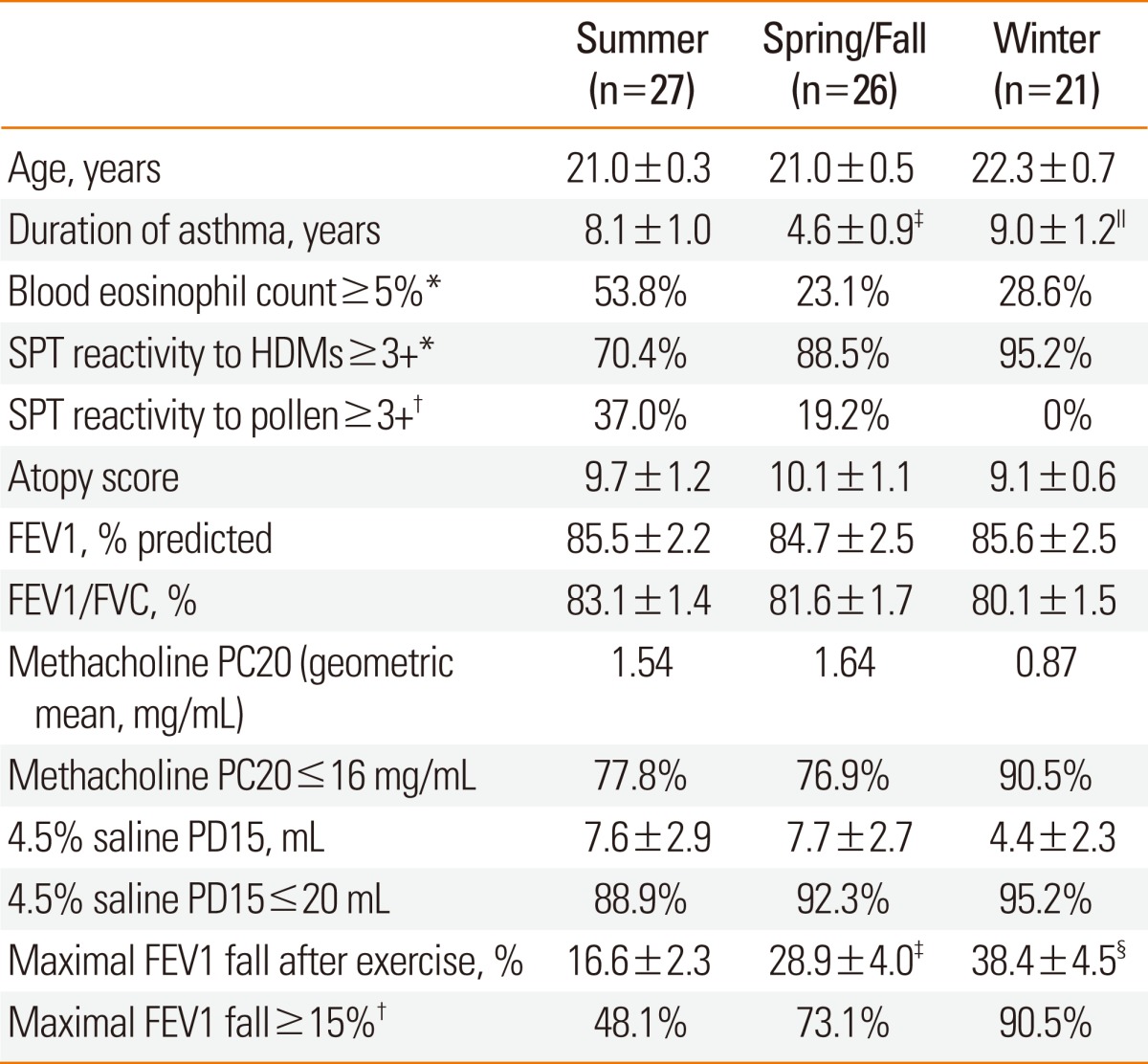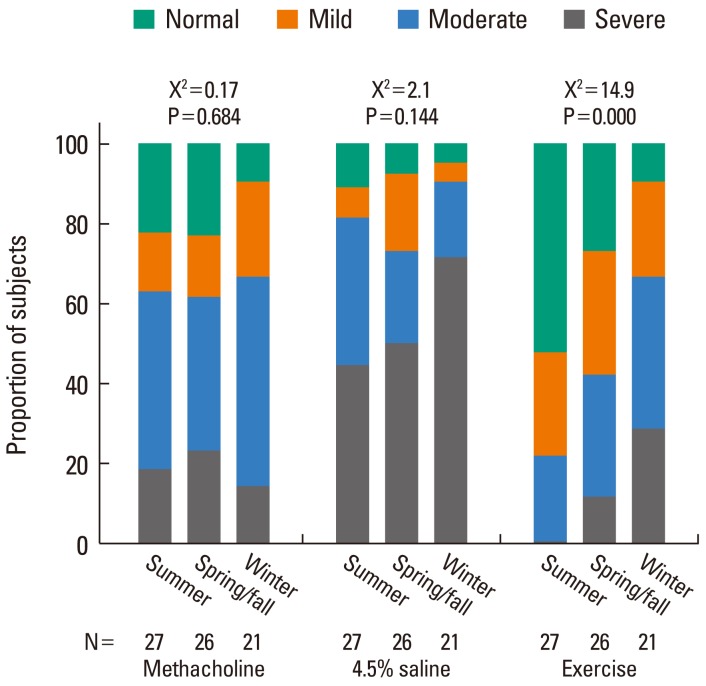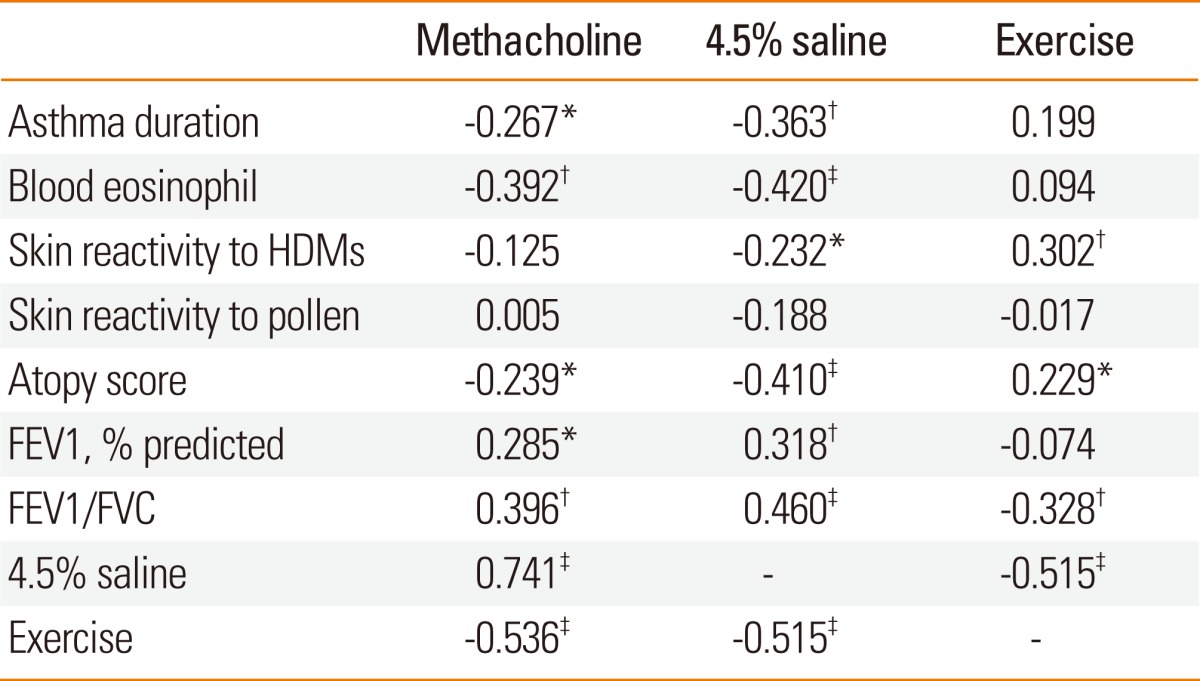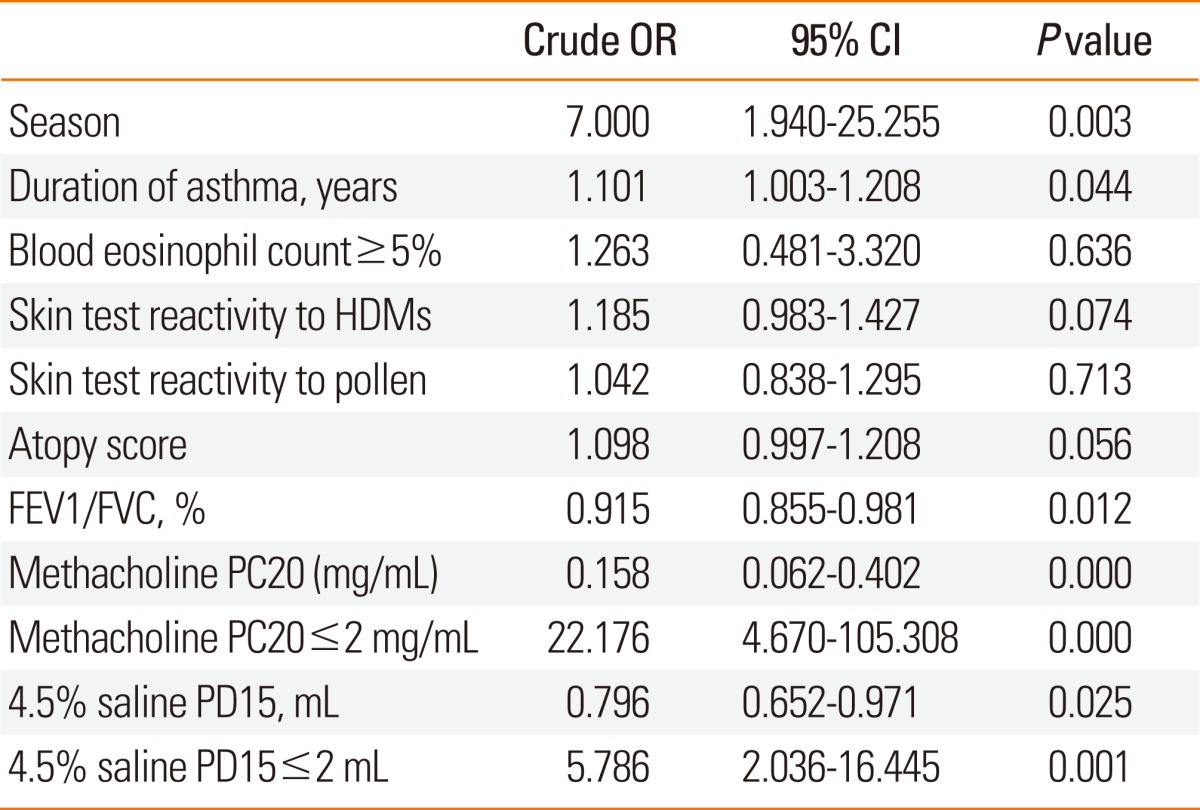1. McFadden ER Jr. Adkinson NF, Bochner BS, Busse WW, Holgate ST, Lemanske RF, Simons FER, editors. Approach to the patient with exercise-induced airway narrowing. Middleton's allergy: principles & practice. 2009. 7th ed. Philadelphia: Mosby;p. 1385–1393.

2. Choi IS, Chung SW, Koh YI, Sim MK, Hong SN, Moon JS. Airway hyperresponsiveness to hypertonic saline as a predictive index of exercise-induced bronchoconstriction. Korean J Intern Med. 2005; 20:284–289. PMID:
16491825.

3. Kim CS, Choi IS, Kim SH, Woo H, Sim HJ, Han ER. A longitudinal study on the relationship between methacholine airway hyperresponsiveness and exercise-induced bronchoconstriction. Korean J Med. 2009; 77:472–479.
4. Koh YI, Choi IS. Seasonal difference in the occurrence of exercise-induced bronchospasm in asthmatics: dependence on humidity. Respiration. 2002; 69:38–45. PMID:
11844961.

5. Holgate ST, Lemanske RF Jr, O'Byrne PM, Kakumanu S, Busse WW. Adkinson NF, Bochner BS, Busse WW, Holgate ST, Lemanske RF, Simons FER, editors. Asthma pathogenesis. Middleton's allergy: principles & practice. 2009. 7th ed. Philadelphia: Mosby;p. 893–919.

6. Han ER, Choi IS, Lee S, Cho YW. Airway hyperresponsiveness-related aeroallergens in suspected asthma. Korean J Asthma Allergy Clin Immunol. 2007; 27:105–110.
7. Choi IS, Koh YI, Koh JS, Lee MG. Sensitivity of the skin prick test and specificity of the serum-specific IgE test for airway responsiveness to house dust mites in asthma. J Asthma. 2005; 42:197–202. PMID:
15962877.

8. Sears MR, Herbison GP, Holdaway MD, Hewitt CJ, Flannery EM, Silva PA. The relative risks of sensitivity to grass pollen, house dust mite and cat dander in the development of childhood asthma. Clin Exp Allergy. 1989; 19:419–424. PMID:
2758355.

9. Gergen PJ, Turkeltaub PC. The association of individual allergen reactivity with respiratory disease in a national sample: data from the second National Health and Nutrition Examination Survey, 1976-80 (NHANES II). J Allergy Clin Immunol. 1992; 90:579–588. PMID:
1401641.
10. van der Heide S, De Monchy JG, De Vries K, Dubois AE, Kauffman HF. Seasonal differences in airway hyperresponsiveness in asthmatic patients: relationship with allergen exposure and sensitization to house dust mites. Clin Exp Allergy. 1997; 27:627–633. PMID:
9208182.

11. Crisafulli D, Almqvist C, Marks G, Tovey E. Seasonal trends in house dust mite allergen in children's beds over a 7-year period. Allergy. 2007; 62:1394–1400. PMID:
17983374.

12. Henriksen JM. Exercise-induced bronchoconstriction. Seasonal variation in children with asthma and in those with rhinitis. Allergy. 1986; 41:499–506. PMID:
3789331.
13. Karjalainen J, Lindqvist A, Laitinen LA. Seasonal variability of exercise-induced asthma especially outdoors. Effect of birch pollen allergy. Clin Exp Allergy. 1989; 19:273–278. PMID:
2736428.

14. Morris AH, Kanner RE, Crapo RO, Gardner RM. Clinical pulmonary function testing. a manual of uniform laboratory procedures. 1984. 2nd ed. Salt Lake City, UT: Intermountain Thoracic Society.
15. Crapo RO, Morris AH, Gardner RM. Reference spirometric values using techniques and equipment that meet ATS recommendations. Am Rev Respir Dis. 1981; 123:659–664. PMID:
7271065.
16. Lazo-Velásquez JC, Lozada AR, Cruz HM. Evaluation of severity of bronchial asthma through an exercise bronchial challenge. Pediatr Pulmonol. 2005; 40:457–463. PMID:
16175592.

17. Iredale MJ, Wanklyn SA, Phillips IP, Krausz T, Ind PW. Non-invasive assessment of bronchial inflammation in asthma: no correlation between eosinophilia of induced sputum and bronchial responsiveness to inhaled hypertonic saline. Clin Exp Allergy. 1994; 24:940–945. PMID:
7842363.

18. Anderson SD, Brannan JD. Methods for "indirect" challenge tests including exercise, eucapnic voluntary hyperpnea, and hypertonic aerosols. Clin Rev Allergy Immunol. 2003; 24:27–54. PMID:
12644717.

19. Cockcroft DW. Hargreave FE, Woolcock AJ, editors. Measurement of airway responsiveness to inhaled histamine or methacholine: method of continuous aerosol generation and tidal breathing inhalation. Airway responsiveness: measurement and interpretation - proceedings from a workshop held at Mont Ste. Marie, Quebec, June 15-17, 1983-. 1985. Mississauga, ON: Astra Pharmaceuticals Canada Ltd;p. 22–28.
20. Woolcock AJ, Jenkins CR. Assessment of bronchial responsiveness as a guide to prognosis and therapy in asthma. Med Clin North Am. 1990; 74:753–765. PMID:
2186241.

21. Cockcroft DW. Barnes PJ, Grunstein MM, Leff AR, Woolcock AJ, editors. Airway responsiveness. Asthma. 1997. Philadelphia: Lippincott-Raven Publishers;p. 1253–1266.
22. Crockcroft DW, Murdock KY, Berscheid BA. Relationship between atopy and bronchial responsiveness to histamine in a random population. Ann Allergy. 1984; 53:26–29. PMID:
6742522.
23. Adinoff AD, Rosloniec DM, McCall LL, Nelson HS. Immediate skin test reactivity to Food and Drug Administration-approved standardized extracts. J Allergy Clin Immunol. 1990; 86:766–774. PMID:
2229841.

24. O'Byrne PM. Middleton E, Reed CE, Ellis EF, Adkinson NF, Yunginger JW, Busse WW, editors. Airway hyperresponsiveness. Allergy: principles & practice. 1998. 5th ed. Toronto, ON: Mosby;p. 859–866.
25. Van Schoor J, Joos GF, Pauwels RA. Indirect bronchial hyperresponsiveness in asthma: mechanisms, pharmacology and implications for clinical research. Eur Respir J. 2000; 16:514–533. PMID:
11028670.

26. Godfrey S. Barnes PJ, Grunstein MM, Leff AR, Woolcock AJ, editors. Exdercise-induced asthma. Asthma. 1997. Philadelphia: Lippincott-Raven Publishers;p. 1105–1119.
27. Cockcroft DW, Davis BE. Mechanisms of airway hyperresponsiveness. J Allergy Clin Immunol. 2006; 118:551–559. PMID:
16950269.

28. Choi IS, Hong SN, Lee YK, Koh YI, Jang AS, Lee HC. Asthmatic airway inflammation is more closely related to airway hyperresponsiveness to hypertonic saline than to methacholine. Korean J Intern Med. 2003; 18:83–88. PMID:
12872444.

29. Anderson SD. Indirect challenge tests: Airway hyperresponsiveness in asthma: its measurement and clinical significance. Chest. 2010; 138:25S–30S. PMID:
20668015.
30. Anderson SD, Gibson P. Barnes PJ, Grunstein MM, Leff AR, Woolcock AJ, editors. Use of aerosols of hypertonic saline and distilled water (fog). Asthma. 1997. Philadelphia: Lippincott-Raven Publishers;p. 1135–1149.
31. Platts-Mills TA, Hayden ML, Chapman MD, Wilkins SR. Seasonal variation in dust mite and grass-pollen allergens in dust from the houses of patients with asthma. J Allergy Clin Immunol. 1987; 79:781–791. PMID:
3571770.
32. Kim JH, Choi SY, Lee IY, Lee YW, Yong TS, Kim CW, Song YS, Park JW, Kim YS, Park JW, Hong CS. Seasonal variation of house dust mite and its influence on the inhabitant health. Korean J Asthma Allergy Clin Immunol. 2006; 26:27–34.
33. Kim E, Kim MJ, Lee JS, Yoon JS. Association between autumnal exacerbation and Dermatophagoides pteronyssinus specific IgE in childhood asthma. Pediatr Allergy Respir Dis. 2007; 17:242–248.
34. Riccioni G, Di Stefano F, De Benedictis M, Verna N, Cavallucci E, Paolini F, Di Sciascio MB, Della Vecchia R, Schiavone C, Boscolo P, Conti P, Di Gioacchino M. Seasonal variability of non-specific bronchial responsiveness in asthmatic patients with allergy to house dust mites. Allergy Asthma Proc. 2001; 22:5–9. PMID:
11227919.

35. Koh YI, Choi IS. Blood eosinophil counts for the prediction of the severity of exercise-induced bronchospasm in asthma. Respir Med. 2002; 96:120–125. PMID:
11860169.









 PDF
PDF ePub
ePub Citation
Citation Print
Print


 XML Download
XML Download